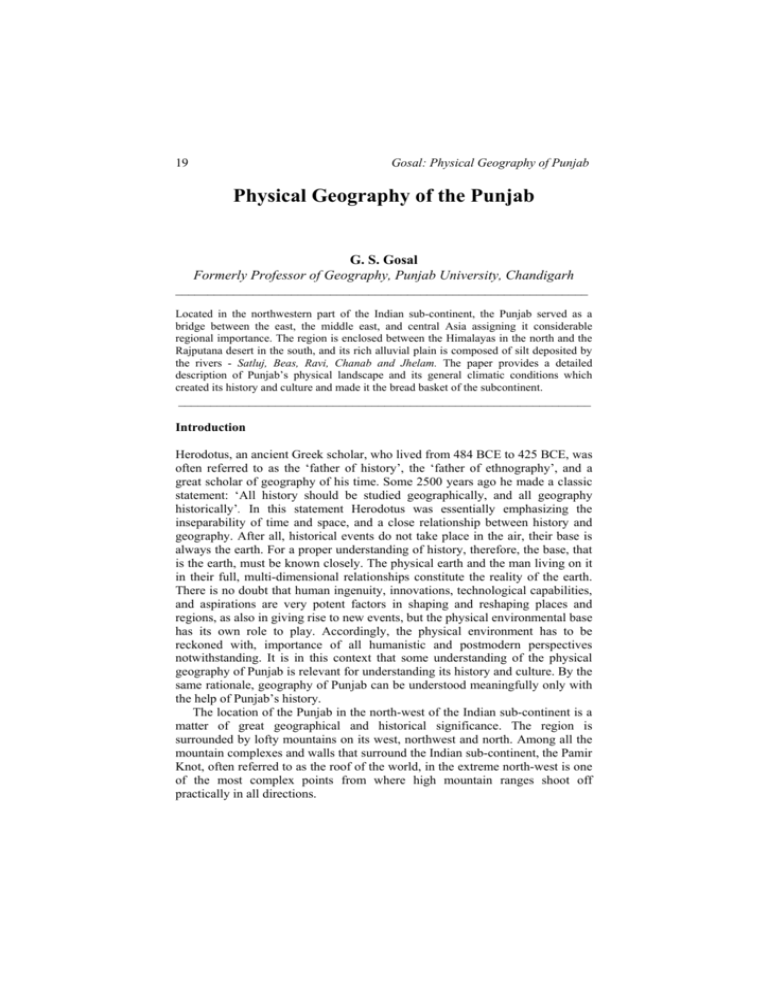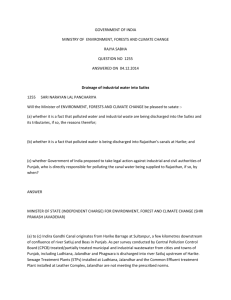Physical Geography of the Punjab - Global and International Studies
advertisement

19 Gosal: Physical Geography of Punjab Physical Geography of the Punjab G. S. Gosal Formerly Professor of Geography, Punjab University, Chandigarh ________________________________________________________________ Located in the northwestern part of the Indian sub-continent, the Punjab served as a bridge between the east, the middle east, and central Asia assigning it considerable regional importance. The region is enclosed between the Himalayas in the north and the Rajputana desert in the south, and its rich alluvial plain is composed of silt deposited by the rivers - Satluj, Beas, Ravi, Chanab and Jhelam. The paper provides a detailed description of Punjab’s physical landscape and its general climatic conditions which created its history and culture and made it the bread basket of the subcontinent. ________________________________________________________________ Introduction Herodotus, an ancient Greek scholar, who lived from 484 BCE to 425 BCE, was often referred to as the ‘father of history’, the ‘father of ethnography’, and a great scholar of geography of his time. Some 2500 years ago he made a classic statement: ‘All history should be studied geographically, and all geography historically’. In this statement Herodotus was essentially emphasizing the inseparability of time and space, and a close relationship between history and geography. After all, historical events do not take place in the air, their base is always the earth. For a proper understanding of history, therefore, the base, that is the earth, must be known closely. The physical earth and the man living on it in their full, multi-dimensional relationships constitute the reality of the earth. There is no doubt that human ingenuity, innovations, technological capabilities, and aspirations are very potent factors in shaping and reshaping places and regions, as also in giving rise to new events, but the physical environmental base has its own role to play. Accordingly, the physical environment has to be reckoned with, importance of all humanistic and postmodern perspectives notwithstanding. It is in this context that some understanding of the physical geography of Punjab is relevant for understanding its history and culture. By the same rationale, geography of Punjab can be understood meaningfully only with the help of Punjab’s history. The location of the Punjab in the north-west of the Indian sub-continent is a matter of great geographical and historical significance. The region is surrounded by lofty mountains on its west, northwest and north. Among all the mountain complexes and walls that surround the Indian sub-continent, the Pamir Knot, often referred to as the roof of the world, in the extreme north-west is one of the most complex points from where high mountain ranges shoot off practically in all directions. JPS: 11:1 20 For some distance westwards from the Pamirs lies the Hindu Kush; then follows the tangle of hills on the northwest frontier which merge into the Sulaiman Range between the Punjab and northern Baluchistan. A re-entrant in the wall, at the head of which lies the Bolan Pass, separates the Sulaiman Range from the Kirthar Range, which lies between Sind and southern Baluchistan. The Sulaiman and Kirthar ranges which extend from the Makran coast toward the Pamirs are the chief mountains in the west. Map of NW Himalayas The Sulaiman presents a steep slope to the Indus plains. What is worthy of emphasis is the completeness of this mountain rampart, and hence the importance which attaches to the few possible passes. Undoubtedly the weakest region is in the northwest on the Afghan frontier, and it is from this direction that Punjab has been invaded again and again. The chief routes in the northwest are: (1) the Bolan Pass, (2) Khyber Pass, and (3) the Gomal Pass. Still another route lies along the Makran coast. Alexander arrived by a route rather north of the Khyber Pass and returned by the Bolan Pass. These mountains – the Himalayas and their subsidiary ranges – constitute the loftiest mountain barrier in the world. Of the 94 Asiatic peaks which exceed 24000 feet, all but two are in the Himalayas and the Karakoram. These mountains shut off the Indian subcontinent from the rest of Asia. From about 240 kms to 400 kms wide, this tallest of the mountain system stretches for over 2400 kms across the north of India. The mountain ranges curve southward at either end. To the northwest, north and northeast the mountains rise abruptly from the plains. The Himalays contribute greatly to the soil, climate and isolation of Punjab. It is often appropriately said that the key to the Indian sub-continent’s geography, more so of its northwestern region, lies outside than inside its 21 Gosal: Physical Geography of Punjab boundaries, although it has its main effects inside. The Himalayan Mountains are eroding rapidly and send out rich loam to the plains below. All the rivers bring down silt which adds and renew the fertility of the soil through annual floods. This alluvium is extremely thick. Borings have penetrated it to a depth of about 1300 feet without reaching a rocky bottom. The plain is exceptionally flat, on the whole. The climate of the sub-continent is mostly tropical. The Himalayan barrier effectively shuts off the sub-continent from the cold northerly winds of the Asiatic continental shield, and at the same time bottles up and concentrates the monsoon winds blowing up from the tropical seas. The real traffic across the mountainous frontiers comes by mule and camel, in seasons when the passes are open. In fact, within the mountainous zones, the terrain is too difficult and complex for human mobility and contact in many parts, all technological advances notwithstanding. Even before the conquests of Alexander the Great in 326 BCE, the northwestern frontier was the avenue of invaders. The Khyber Pass leads to Kabul in Afghanistan, and the Bolan Pass to Quetta in Baluchistan; between them is the Gomal Pass. These and other gateways have been of great historical significance to the region. The glaciers of the Himalayas and Tibet, although much shrunken, nevertheless include in the Karakoram the largest glaciers remaining in the world outside sub-polar regions Siachen glacier, which is of great strategic importance, is 720 kms long. Western glaciers which are of great size descend to lower levels – in Kashmir as low as 7000-8000 feet. Geographically the Himalayas have been divided into five longitudinal zones: (i) the outer zone of Shivalik Hills and the duns or longitudinal valleys behind them; (ii) the Lesser Himalaya, including a great number of minor ranges at 6000-10,000 feet; (iii) the zone of spurs from the main ranges, presenting the aspect of a very highly dissected peneplain at about 15000 feet; (iv) the Great Himalaya itself with many peaks of over 20,000 feet; (v) the Indus-Tsangpo furrow at about 12000-14000 feet; this is succeeded by the worn-down mountains of the edge of the Tibet Plateau, upto 19000 feet high. The above brief comments about the mountain and their zonal divisions are helpful in understanding the Punjab’s entry points from the northwest in the past, their rivers, soils and climate. The Punjab The British Punjab, the central core of which comprised the land of five rivers – the Satluj, the Beas, the Ravi, the Chanab and the Jhelam covered an area of 346,389 sq. kms. which is nearly seven times the area of the present East Punjab JPS: 11:1 22 after its reorganization. Although the physical geography of the land is practically unchanged in a macro-regional perspective, the new divisions have brought about some local changes in its landscape when viewed from microlevel angles. These micro-level changes in physical and non-physical aspects are important in their emerging landscapes and in the current processes of their development, and will be potent factors in the years to come. Thus separate references to East and West Punjabs, while discussing their physical geography, will be in order wherever relevant and called for. Situated in northwestern, it is a border state, far removed from the Arabian sea and the Bay of Bengal, East Punjab is an inland state par excellence – a fact which is full of implications: strategic, political and socio-economic. Roughly triangular in shape, the state extends from 29°30’N to 32°32’N latitude, and 73°55’E to 76°50’E longitude. It has a sensitive location. It borders with Pakistan on its west. To its north lies the important state of Jammu and Kashmir. Himachal Pradesh is on its northeast and east, and Haryana to its southeast and south. Its small and compact size (50,362 sq.kms) lends easy accessibility to all parts of the state, a fact which has great significance from the point of view of socio-economic development and defence. Western Punjab (in Pakistan) is bordered on its far north and northwest by the NWFP and the snowcapped Hindu Kush mountains and the high Karakoram Range. Relief Lying between the Yamuna river on the east and the Indus on the west (in fact, even going beyond the Indus), and fringed by a dissected foot-hill zone and the Shivalik Hills in the northeast and the north, the Punjab is an extensive alluvial plain gently sloping from about 350 metres above sea-level in the northeast and the north to about 180 metres in the southwest. The southwestern fringe of the region is desertic and undulating, but has gradually been becoming level with the extension of cultivation and irrigation. At the micro-regional level, man’s activities have been a major agent of change in moulding surface configuration. It is also noteworthy that the East Punjab has experienced more of such microregional changes in topography than its counterpart in the West. The region is a great mass of alluvium brought down by the Indus and the five rivers, uniting in the southwest at Panjnad (five streams). In between the Yamuna and the Satluj in the east, the Ghaggar river and its tributaries contributed to the same process of alluviation in what is now called the Malwa Tract. 23 Gosal: Physical Geography of Punjab Map of Punjab showing the Core Region With about 90 per cent of the total area as plain (comprising the low lying flood plains along the rivers and the monotonously flat upland plains between them), the Punjab is an extensive level tract of land. Such a characteristic of the region’s relief, among other factors, has facilitated cultivation of the land to the farthest limits, extension of irrigation, wherever developed, all over, and construction of roads, and railways possible. In making use of such favourable JPS: 11:1 24 topography, the East Punjab, with 84 percent of the total land area is sown and 95 per cent of the total cropped area irrigated and practically all villages linked by metalled roads, has a clear edge over West Punjab where much remains to be done in these developmental activities. West of the Jhelam-Chanab flood plain (bet) there is abrupt decline in the proportion of net sown area to total land area in conformity with increasing dry conditions and fall in irrigated area. Rural link roads, likewise, are few and far between in the western districts which suffer from desertic conditions. The only departures from the alluvial monotony of the flat plains of the region are the little groups of arid broken hills near Sangla and Kirana, on either side of the Chanab. These are very small in extent but rise in jagged pinnacles about 1000 feet above the plains, and are geomorphologicaly of great interest, as they are outliers of the Aravalli system. Likewise, there is evidence of concealed ridges prolonging the Aravalli axis between Delhi and Hardvar. In general, on this aggardational surface of the plains the main topographical changes are associated with numerous shifts and diversions in the rivers’ courses, as also developmental activities related to extension of agriculture and irrigation. The flood plans along the rivers are made of new alluvium deposited by the rivers themselves, while the upland plains above consist of old alluvium. The interfluves are given names compounded from those of their confining streams: Bist Doab (between Satluj and Beas), Bari Doab (between Beas and Ravi), Rachna Doab (between Ravi and Chanab), Chaj Doab (between Chanab and Jhelam). Land-form Regions Although at the macro-regional level, the Punjab plain is a predominantly flat and featureless land, it reveals a lot of diversity of relief when viewed from micro-regional levels. The whole Punjab region may be divided into the following landform types: 1. The shivalik Hills 2. The dissected foot-hill zone 3. The 5 upland plains and the Malwa tract 4. The flood plains along all the rivers 1. The Shivalik Hills The whole region is bordered by the Shivalik hills on its northwest, north and northeast. They extend further eastwards as far as Kosi River along the foot of the Himalayas. They are fairly wide in the north-west and the north, and are only a narrow zone in the northeast. The Shivaliks are formed of great thicknesses (15,000-20,000 ft) of Mio-Pleistocene sands, gravels and conglomerates. Obviously erosion products of the Himalayas themselves, and not very high (often below 1000 metres), they bear striking witness to the extreme youth of the process of mountain building. They are backed by a 25 Gosal: Physical Geography of Punjab discontinuous series of longitudinal valleys (duns). The front to the plains is remarkably even and regular. The Shivalik hills generally range between 300 metres and 1000 metres above sea level. They provide a sharp contrast to the predominantly level topography in much of the region. They are quite denuded and dissected and generally covered with only bush and stunted vegetation, thanks to their deforestation in the later part of the nineteenth century, of course in varying degree throughout their length. There are no extensive forests any more. The impact of their denudation and dissection on the foot-hill zone below is still persisting. 2. The Dissected Foot-hill Zone At the foot of the Shivalik hills, all along, stretches a narrow, 10 to 15 kms wide dissected undulating zone. In the East Punjab a highway links Chanidgarh to Pathankot via Hoshiarpur. Throughout this foot-hill zone there are seasonal streams, locally called chos, cutting across the tract. These chos originate from the Shivalik hills above. Most of them came into existence subsequent to the deforestation of the Shivalik hills to meet timber requirements for construction. The chos are generally quite closely spaced, sometimes only a kilometre apart. They do not run for long distances. Instead, they disappear as inland streams after a course of some ten to fifteen kilometres. These chos caused large scale soil erosion, gully erosion, destruction of farm land and fall in water table. In fact, they worked havoc with most facets of human life in the entire zone in varying degrees. The part of this foothill zone is locally called the Kandi tract. In terms of spacing of chos and the destruction they caused, Hoshiarpur district (in East Punjab) was the worst affected. These chos become a great hindrance in road building and year-round road transport in the whole foothill zone, severely affecting mobility of men and materials. The chos have been bridged, state highways and rural link roads built, restoring easy mobility and accessibility in most parts of the Kandi. Water table is still quite deep, making it difficult for small farmers to install their own tubewells. State governments have to come in a major way to help the people. Re-afforestation programmes need to be implemented effectively and speedily. A topographic over-view of the zone reveals the following common features: (i) closely spaced chos which have badly dissected the land, (ii) convex interfluves between the chos, (iii) surface configuration irregular or undulating on the interfluves, (iv) coarse and stony soils which are not easy to plough, (v) maximum ruggedness and dissection close to the hills, becoming less and less downstream. These features have stood in the way of development of the zone. Now the chos are being tamed; State tubewells have been installed to provide irrigation. Efforts are being made to revive the economy and to improve the quality of life. Overseas Punjabis are playing a positive role in extending education in the zone. They have initiated a new movement of ‘model villages’ in cooperation with the local residents, initiating a kind of social revolution. These developments have particularly taken place in Hoshiarpur district which JPS: 11:1 26 has experienced large scale emigration to foreign lands, especially to Australia, New Zealand, Canada, UK and USA throughout the 20th century. Elegant farmhouses along the main highways give an indication of the socio-economic changes that are taking place. The foot-hill zone in West Punjab covering parts of Sialkot, Gujrat, Jhelam and Rawalpindi districts shares most of the physical features discussed above, but less of development activities aimed at improving the economy and quality of life. It may be noted that human action is one of the important determinants of change in physical landscape at local levels, along with natural factors. The role of the state is of paramount importance. 3. The Upland Plains The upland plains are essentially interfluvial tracts. From the Satluj to the Indus the Punjab plain gradually slopes westward resulting in the westward shift of the rivers’ courses. Near the Indus the land is 100 metres below sea level. All these plains are made of old alluvium originally deposited by the major rivers descending from the Himalayas. The plains look flat and featureless for the most part. They generally slope from the northeast to the southwest, the elevation decreasing by about four metres to a kilometer in the upper parts, and by less than a metre to a kilometre in the lower parts. Although, on the whole, the surface cover is the result of alluviation by river action throughout the region, wind action has been important in the southern and southwestern fringe lands. The southern area in the Sind-Sagar Doab is a part of the Thal desert, so is the former Bahawalpur state. In these parts of the Thal the surface is covered by sand-dunes which are at times about 100 feet above the plain level. The Sind-Sagar Doab is still a predominantly desertic tract. The Western Malwa tract, which was strewn with sand-dunes in early 1950s, has been levelled and brought under cultivation with the help of canal and tubewell irrigation, now looks like any other well developed plain area. The southern parts of West Punjab which have a much drier climate than their counterparts on the East side have relatively different surface conditions. The southern part of the Sind-Sagar doab has not been covered by inundation canal irrigation and is still retaining its old desert relief in parts. Even in the southern Bari and Rachna Doabs conditions are dry. They have been referred to as Ganji bar (dry waste lands) and Neeli bar respectively. But with the extension of the canals from the Triple Canal Project of West Punjab, these earlier dry wastelands have been brought under cultivation and canal irrigation in a planned way and transformed into some of the most prosperous agricultural areas. It may be in order to mention in this context that despite the addition of the internationally known Bhakra canal, the irrigation canal network in East Punjab is only a poor copy of what was accomplished in West Punjab, both in terms of areal coverage and imaginative integrated irrigational planning during the British period. In eastern Punjab, the deficiency has been more than made up by the widespread development of tubewell irrigation which supplements the canals in a major way whenever and wherever necessary. 27 Gosal: Physical Geography of Punjab In the Malwa Tract, similar physiographic changes took place but in a different context. There was a discontinuous chain of sand dunes south of the Satluj flood plain. There are different viewpoints with regard to the origin of these sand dunes. Some thought they were made by sand carried by the winds from the sandy bed of the river Satluj, while others are of the opinion that they were deposited by the river itself when it was following an easterly course along these sand dunes which formed linear belts. Ever since the river has shifted its course to the west, leaving mounds of sand in its earlier course. The latter view is far more dominant. In any case, with the completion of consolidation of landholdings and extension of irrigation from the tube-wells these dunes have been obliterated, converting an erstwhile undulating sandy surface to a level land practically everywhere. With these developments, there is a radical change in crops. Peanut cultivation which was dominant in this sandy belt has given place to wheat and paddy cultivation. Under the combined impact of the various developments referred to above, the very nature of soils has changed and the economy has been transformed. Khanna town which was a well-known market for peanuts does not have a trace of it now. Instead, it is one of the country’s most important mandis (market places) for wheat. Putting all these changes together, it may be seen that the Punjab plain (from the Malwa tract in the east to the Sind Sagar Doab in the west) has experienced vast changes in its relief and economy at the local levels. The macro-regional view, however, continues to remain the same. 4. The Flood Plains The flood plains are formed of new alluvium deposited by the rivers during the rainy season every year. Generally, they are separated from the upland plains by low scraps, at places even by steep cliffs. These flood plains along the rivers are linear tracts having a width not more than 10 to 15 kilometres. The flood plains remained wastelands till recently, but now practically all are under extensive cultivation. Since they have been shifting their courses in varying degrees to the west, their western banks are relatively steep leaving little scope for their development. The flood plains on the eastern side of the rivers, on the other hand, are relatively extensive and wide. The flood plain of the Satluj starts from the point the river enters the plain near Ropar and extends upto the vicinity of Fazilka town in Ferozepur district. It is much wider in the south of the river than to its north due to westward shift of its course. A section of the flood plain lies between the Satluj and Budha Nala which was the old course of the river. The presence of the remnants of oxbow lakes between the old course and the present one provide demonstrative evidence of the shift of the river’s course to the west. An extensive flood plain tract is formed near Harike where the Satluj is joined by the Beas. As the river moves into the arid areas further and further, the intensity of water in it decreases, and accordingly the flood plain becomes progressively narrow, or even non-existent at places in Bahawalpur state. JPS: 11:1 28 The Ghaggar river, into which the Satluj was thought to be flowing in the past, has a fairly wide flood plain. It runs along the eastern margins of Patiala and marks the southern tips of Sangrur and Mansa districts. It is subject to frequent flooding during the rainy season and requires control measures to be effectively taken to save the adjoining farmland. The flood plain of the Beas comprises a large part of Dasuya tehsil of Hoshiarpur district and western half of Kapurthala tehsil. Because of the westward shift of Beas the flood plain is much wider east of the river than to the west. On the western side it is separated from the upland plain by a relatively steep cliff which at places is more than 50 feet in height. The eastern side of the flood plain extends upto the Black Bein which is said to have been the old course of the Beas. The flood plain of the upper Ravi lies between the river and the Sakki-Kiran stream which is thought to have been the old course of the river. The flood plain is 10 to 15 kilometres wide, but at places, as in Gurdaspur tehsil, it is only 3 to 4 kilometres. The flood plain of the lower Ravi is wider, widening with the western shift of the river in the past. The flood plains of the Chanab and the Jhelam are relatively wide east of the rivers, while on the western side the river banks are steep and without any flood plains. The combined Chanab and Jhelam rivers, after their confluence, also have a similar location of their flood plains on the eastern side and very little along their western banks which are relatively steep. But it is noteworthy that since much of the water in the two rivers, before their confluence, flows into the extensive canal system the floods are less frequent and flood plains less wide and less extensive in relative terms. The narrow flood plains that do exist have not been brought under cultivation as much as they have been in East Punjab. Likewise the Indus river has shifted to the west, leaving behind a linear belt of flood plains on its eastern side. Variations in degrees notwithstanding, all the rivers have shifted to the west, giving rise to small relief features of different dimensions. The westward shift of the rivers appears to have been caused by a tectonic movement uplifting the Yamuna-Satluj divide. There is a westward tilt in this uplift. At the same time the eastern part of the divide experienced some eastward tilt pushing the Yamuna eastward to join the Ganga. In conclusion the micro-regional topography of the entire region is closely connected with the erosional and depositional work of the rivers and their westward shifts. These micro-level features have been and still are of great significance in economic, social and strategic terms. The topographic homogeneity at the macro-regional level in the entire old region gives place to diversity of relief when viewed from micro-regional levels. Drainage The drainage system comprises five perennial riverine, numerous seasonal streams and hundreds of gullies. The Ghaggar is a truncated seasonal stream at present, but a victim of river capture and river diversion resulting from the tectonic events that occurred in this region in the past. The discharge of the 29 Gosal: Physical Geography of Punjab perennial rivers is subject to wide fluctuations ranging from a flush in August to a low current in April. The Satluj and other perennial streams are not dependent on monsoon rainfall alone for their water supply, but have also supply from the melting of the Himalayan snows. This is more valuable as it comes in the spring and early summer – March, April and May. Of course it is variable but it helps in making water available for irrigation for a much longer period of the year. The Satluj Among the five rivers of the core region, the Satluj is indeed the major stream. It has its source in one of the westerly Mansarovar lake in Tibet located at 30°20’N and 81°25’E at an elevation of 4633 metres above sea level. Satluj is an antecedent stream. It existed before the emergence of the Himalayan ranges, which it cuts across during its journey to the plains. While cutting across the high mountain ranges it has formed deep gorges. The presence of terraces at different levels of the valley sides indicates different phases of uplift of the Himalayas. The Himalayas are still rising. In terms of length of its course, the Satluj is second only to the Indus river. After originating in the Mansarovar, the Satluj follows a northwesterly course along the slopes of Kailash mountain before entering the Shipki La. Thence it bends southwest and makes its way through the mountainous and hill topography till it enters the Shivalik foothills near Nangal. A few miles above, the Bhakra dam has been constructed across the river. At this point, the river flows with northwest-southeast orientation through the Jaswan dun between two ranges of the Shivalik hills in Ropar district. At Ropar it pierces through the hills and enters the plain proper, and here it takes a sharp westward turn. The Satluj separates the Bist Doab in the north from the Malwa tract in the south. At Harike it is joined by the Beas. Thence it adopts a southwesterly course. It marks the boundary between East and West Punjab from near Ferozepur to Fazilka for about 120 kilometres. From there it follows a southwesterly course to meet the joint course of the Ravi, Chanab and Jhelam rivers (Trimab-Three rivers). This meeting point of the combined Satluj-Beas and the Trimab (Ravi, Chanab and Jhelam) is called the Panjnad (five rivers). Some 70 kms downstream the combined waters of the five rivers join the Indus river a little above Mithankot in the far southern part of western Punjab. Of the total length of about 1450 kms, the Satluj flows for about 1050 kms in the east and drains about 25,900 sq.kms of area. The East Punjab owes a lot of its prosperity to the Satluj. The Bhakra dam on the Satluj not only provides the precious hydro-electric power but also saves the state from floods. The Nangal Barrage canal originated at Nangal, the Sirhind and the Bist Doab canals starting from Ropar, the Sirhind feeder and Rajasthan canal with their source at Harike and the Bikaner canal with its headworks at Hussainwala, all derive their water from this river. The Satluj has changed its course a number of times, even during recorded history. The river, as part of the mighty Ghaggar system, followed an independent course in early times to find an outlet into the Rann of Kachh. JPS: 11:1 30 Some 5000 years back it was passing by Jaisalmer. The river bed was 500 metres to 1.5 kilometer wide. Subsequent to a gradual tectonic uplift of the Yamuna-Satluj Divide it started shifting to the west. Ropar-Sirhind axis, with Sanghol on it, was its course at one time. Till recently the axis was a low lying area in which the water used to flow like a river during heavy rains. But now the land is all levelled and developed. Before the Satluj shifted from its old course in Budha Nala to the present course, Ludhiana was situated on its eastern bank. After a few centuries’ westward shift, the Satluj became a part of the Indus system. The westward shift from time to time is evidenced by remnants of its abandoned courses. Along the dry Hakra bed – the old course of the mighty Ghaggar river with Satluj and Yamuna as its tributaries – also thought to be the ancient Sarasvati river – recent excavations have brought to light the existence of townships of the 5000 years old Indus valley civilization. These excavations are being done in a phased manner and will cover the entire course which in parts is now lying obliterated. Since 1972, topographic, hydrological and national remote sensing investigations done by the Arid Zone Research Institute, Jodhpur, the Physical Research Laboratory, Ahmedabad and the Remote Sensing Agency, Hyderabad have brought out evidence for the existence of a mighty river in the dry bed reconstructed upto the Rann of Kachh. The areas have been mapped by satellites. The Beas Beas rises from the southern face of Rohtang Pass (4062 metres above sea level) in the Kullu district. After its hill journey it enters the Punjab plain near Mirthal where it is joined by the Chakki stream. The construction of the Pong dam at Talwara has drastically reduced the flood menace of the river and has permitted extension of cultivation, especially in Dasuya, Gurdaspur and Kapurthala tehsils. The Beas joins the Satluj at Harike after flowing over a hundred and fifty kilometers, separating the upper Bari Doab from the Bist Doab. Before the sudden westward turn of the Satluj, the Beas was a big river, flowing separately to join the Ravi some distance south of Multan. At that time it traversed through a large part of the Punjab plain. At present Beas is a comparatively small river which is only about 460 kms long and lies entirely within the eastern territory. Its total catchment area is about 20,000 sq.kms. The Ravi The Ravi has its source in Kullu district hills near the Rohtang Pass. Flowing in north-westerly direction from its source, it drains the area between the Pir Panjal and the Dhaula Dhar ranges. After passing through Chamba district it enters the Punjab plains near Madhopur where is located the headworks of the upper Bari Doab canal system. Some distance below, the river roughly marks the boundary between East Punjab and West Punjab. It joins the Chanab (actually the combined Jhelam and Chanab waters) a little above Rangpur in West Punjab 31 Gosal: Physical Geography of Punjab after flowing for a distance of about 725 kms from its source. Its total catchment area is 14,442 sq.kms of which only about 6000 sq.kms lies in India.To the west of the Ravi, there is Degh stream which runs parallel to it for about 240 kms before joining it. The place where Ravi joins the combined Jhelam-Chanab course is known as Trimab (three rivers). Throughout its course in East Punjab, the river flows in a comparatively narrow valley. The fluctuations in its discharge are significantly less than those of the Beas. However, in its course in western Punjab, several changes and shifts are thought to have taken place in the past. Most recent of all, the Ravi is said to have been washing Lahore Fort’s walls which now is on the eastern edge of the river’s flood plain. Downstream, it is said, in Tamerlane’s time the Ravi joined the Chanab below Multan. The Chanab used to flow east of Multan. Currently, Multan is a few kilometers east of the joint course of the Ravi and the ChanabJhelam combine and much below the Trimab. The Chanab The Chanab originates from near the Bara Lacha Pass in the Lahaul-Spiti part of the Zaskar Range. Two streams on opposite sides of the pass, Chandra and Bhaga, form its headwaters at about 4900 metres altitude. The combined stream, Chandrabhaga, flows in northwest direction through the Pangi valley, parallel to Pir Panjal Range, and enters Jammu and Kashmir State as the Chanab river. After its course through deep gorges, it enters the plain area near Akhnoor in Jammu and Kashmir. Its total length is 1180 kms. The Jhelam The Jhelam rises in a spring at Verinag at an elevation of about 4900 metres in the southeastern part of the Kashmir valley. The river flows through the Kashmir valley and cuts through Pir Panjal below Baramula. At Muzaffarabad, the river takes a sharp hairpin swing southward. Thereafter it forms IndoPakistan boundary for 170 kms. It comes out in the Punjab plains near the city of Jhelam about 400 kms from its source. About 320 kms lower it joins the Chanab at Trimab. The Indus The Indus, along with its tributaries forms one of the largest drainage systems of the world. It is thought that it is from this river that India got her name. The Indus valley has been the cradle of one of the oldest civilizations in the world. The mighty Indus rises near Mansarovar lake from the glaciers of the Kailash Range in western Tibet at an elevation of 5180 metres. Starting from its source, it flows for a distance of about 260 kms in the northwesterly direction until it is joined by the Ghar. A short distance lower down, it continues to flow in the same northwesterly direction between Ladakh and Zaskar Ranges. The gradient of the river in this course is very gentle (about 30 cms per km). Here it is joined JPS: 11:1 32 by the Zaskar river. About 50 kms before Skardu, it is joined by the Shyok at an elevation of about 2700 metres. The Gilgit, Gortang, Dras, Shiger, Hanza are its other Himalayan tributaries. After passing through a 480 km long antecedent and very deep gorge north of Nanga Parbat, it takes a sharp southerly bend and reaches Attock at an altitude of about 610 metres. Here it ends its mountainous journey and is joined by the Kabul river from Afghanistan. Thereafter it flows through the Pothohar plain and crosses the Salt Range. Just above Mithankot about 805 kms from the sea at an elevation of 79 metres, the Indus receives from Panjnad the accumulated waters of the five eastern tributaries. The river empties itself into the Arabian Sea, south of Karachi after forming a big delta. The total length of the Indus river from its source to its mouth is about 2880 kms. The Indus has a total drainage area of 1,178,440 sq.kms out of which 453,250 sq.kms is in the Himalayan mountains and foot-hills. The rest lies in the Indus plain. West of the Jhelam-Chanab course, in the Sind-Sagar Doab there is a strip of level ground, the Daggar, which runs parallel to the Indus at a distance of some 30 to 40 kms and whose central section is a narrow low depression in which the water table is high enough for well irrigation. This depression is thought to be the abandoned channel of the Indus which since has shifted westward to its present position. Possibly, it cannot shift any further to the west as it has already reached hill ranges on that side, or at least the surface is sloping up from there onwards. Like the Satluj, the Indus is an antecedent river. It is one of the longest in the world, and has one of the larges drainage basins. It is said that the Himalayan section of its drainage area alone is larger than the whole basins of most European rivers. It is notable that most of the rivers of the Indus system have one small perennial stream each to their east, running parallel to and ultimately joining them. These small streams are the abandoned courses of their respective main rivers. All of them together provide evidence for the westward shift of all the rivers of the Indus system. The Ghaggar In addition to the Indus river and its five tributaries there is another historically important stream, the Ghaggar also called Sarasvati, which has been closely linked with the physiographic and cultural evolution of the part of the Punjab plain which is often referred to as the Yamuna-Satluj Divide. At present the Ghaggar is an inland and largely a seasonal stream. It takes its origin from the lower Himalayas in Sirmur district. After a short journey, it enters the plains near Mubarakpur. It traverses through the eastern part of Patiala district, the southern section of Sangrur district and the lower tip of Mansa district. It finally leaves Punjab and moves into Rajasthan to lose itself in the sands near Hanumangarh. Evidently, before too long, the river was of great magnitude and a major barrier, making the linguistic contrast on its two sides sharp. Recent Archaeological Survey of India’s excavations have revealed the existence of flourishing towns along its dried bed of some 5000 years back in 33 Gosal: Physical Geography of Punjab Fatehabad district. These townships are part of the Indus valley civilization. Under the impact of some tectonic disturbances these towns and allied settlements were destroyed and turned into ruins. The nature of the finds in these ruins indicate that it happened some 5000 years ago. The whole river-bed has in due course of time been converted into agricultural land. Farther in Rajasthan a large part of the area was mapped by satellite in Jaisalmer district. According to the evidence before the scientists, it has been established that when it was passing through Rajasthan, it was at places 500 metres to 1.5 km broad. The survey being carried out by various scientific organizations are in the process of identifying and re-constructing the flow channel of the river to its delta in the Rann of Kachh. Even in the contemporary period, the Ghaggar is notorious for its floods all along its course during the rainy season. It has a wide bed throughout but contains only a narrow channel of water. Along its course, at places, there are terraces still identifiable. The Ghaggar has been a prominent, perennial stream with a wide drainage basin in the past, but the processes of river capture and shifts in courses through which this river lost a number of tributaries in its upper course, it has been reduced to a seasonal stream. The Giri river which after following a southerly course suddenly takes a sharp turn to the east to join the Yamuna river, was at one time flowing straight into the Ghaggar forming its upper course. This diversion is possibly due to the rise of the Shivalik range which the Giri could not cross, or some other tectonic disturbance with a similar affect. It is generally thought that the Satluj and the Yamuna rivers at a time were also tributaries of the Ghaggar river. With an uplift of the Yamuna-Satluj Divide the two rivers shifted to the west and the east respectively, causing dismemberment of the once mighty river system. These diversions, river captures and drastic reduction in its upper drainage basin left the Ghaggar as a truncated stream. Sarasvati which is a tributary stream of the Ghaggar now was the old course of the Yamuna which subsequently shifted to the east ultimately to join the Ganga at Allahabad. In sum the Yamuna-Satluj divide which forms an eastern segment of Punjab has been the scene of unprecedented changes in river courses, resulting in many topographic changes at the micro-regional level. The Seasonal Streams (chos) In addition to the main rivers described above, scores of seasonal streams, present another notable feature of the Punjab drainage system. These seasonal streams infest the area immediately south of the Shivalik hills. Most of them start from the southern slopes of these hills, dissect their way through the foothill zone for ten to twenty kilometers and soon exhaust themselves dry, or fall in some nearby river or in one of its tributaries. They make wide beds, filled with sand, stones, and gravels and have small sharp valley walls. They are closely spaced, 3 to 5 kilometres on an average, throughout the foothill zone but their spacing is the closest in Hoshiarpur district where a cho after every kilometer is a common phenomenon. JPS: 11:1 34 These seasonal streams or chos have been a notorious agent of soil erosion. They are now being channelised and diverted by building earth embankments, reinforced by locally available boulders and stones. At places, they are being dammed to store water for irrigation during the dry season. Other but smaller seasonal drainage lines found in the Shivalik hills and their adjoining tracts in the foothill zone are the deep narrow gullies with broken slopes. These gullies are generally the product of mechanical action along their slopes. They come into floods for very short time during any heavy rain. The close spacing of the chos described above and the depth of these gullies act as a severe handicap to the construction of roads in the foothill zone of Punjab. It follows that while the master streams of Punjab provided the base for development throughout, the seasonal streams, most of which evolved recently as a consequence of deforestation of the Shivalik hills, have been a bane. As in the past, so in future, the progress of Punjab, among other things, rests on a rational management of its water resources. Climate General: In conformity with its inland position and sub-tropical location, Punjab is characterized by a continental, semiarid to subhumid climate. Its climatic rhythm, as of other parts of India, is defined by the change of seasons. The contrast between summer and winter is well marked, and these two primary seasons are associated with two main crop seasons of kharif (Fall) and rabi (Spring) respectively. In detail, however, one can distinguish five seasons through the year: (i) summer runs from the middle of April to the end of June, (ii) rains from July to mid-September, (iii) autumn from mid-September to mid-November, (iv) winter from mid-November to mid-February and (v) spring from mid-February to midApril. There may be some year-to-year fluctuations in the time schedule of the various seasons. Dominance of either temperature or of rainfall gives character to each of these seasons. The summer is marked by scorching heat when the sun is bright, chances of rainfall are few, relative humidity is low and dust storms are frequent. Lu (during May and June) during the day restricts outdoor movement but nights are relatively cool. The rainy season is heralded by the arrival of the monsoons, which break the spell of the intense heat. The brown landscape of the summer is changed into green with luxuriant plant life, consisting mainly of crops. Relative humidity remains high and is difficult to bear when it is calm. The postmonsoon autumn season brings in pleasant weather which is generally moderate and dry. Cold season steps in soon and is at its apex around mid-December. This season may experience seven or eight drizzles of rainfall arising from the arrival of the cyclones from the west. Frost is not uncommon. After the cold season the spring moderates the weather. It may, however, be punctuated by a hailstorm and some rain. In any case, it is only a short season. The heat picks up with unusual rapidity. 35 Gosal: Physical Geography of Punjab A study of the annual march of temperature in Punjab confirms the continental nature of its thermal conditions. January is the coldest month, with the mean maximum temperature ranging between 20 to 25°C and the mean minimum being less than 5°C. The mean temperature works to be 10 to 15°C. The difference in the January temperature at different places in Punjab is not too large. By contrast, June is the hottest month. The mean maxima touches 45°C while mean minima are about 20°C. The mean temperature ranges from 30 to 35°C. The intensity of heat is greater in west and southwest Punjab than in the east and the northeast. With the degree of continentality increasing toward the northwestern parts of the sub-continent, western Punjab is hotter in summer than eastern Punjab and the winter colder. Frost is more common in Lahore than in eastern Punjab areas. In fact, mid-November to mid-February is the cold season when mean temperatures are below 20°C. Mid-December to mid-January is the coldest part of the year with mean temperature of around 10°C. Temperatures rise gradually during the spring season, but abruptly after the onset of hot season by the beginning of April. Mid-May to mid-June is the hottest part of the year with mean temperatures of about 35°C. Subsequently, during the rainy season, temperatures fall slightly but remain stable from 25° to 30°C. A combination of high humidity and high temperature makes the weather oppressive most of the time. The post-monsoon but pre-cold season is marked by pleasant temperature, 20 to 25°C. Not only is there a wide range in summer and winter temperatures but also a big difference is experienced in day and night temperatures throughout the year. On average, a day in Punjab receives 7 to 8 hours of sunshine. The span of sunshine received is the longest (8 to more than 10 hours) during April to June and the shortest (5 to 7 hours) during December to March. Thus, temperature conditions remain favourable to plant growth throughout the year. The striking difference in summer and winter temperatures permits cultivation of both tropical and subtropical and even temperate crops. The abundance of sunshine is a potential source for solar energy in future. The Punjab region is semi-arid to sub-humid. Its average annual rainfall is slightly more than 60 cms. Year-to-year fluctuations are great which may be about 25 percent on either side of the annual rainfall. No part of Punjab receives snowfall. There are striking regional variations in the amount of annual rainfall received by different parts of Punjab. These variations are critical to land-use pattern, agricultural productivity and population distribution. Rainfall varies from about 150 cms in the Shivalik hills in the north and northeast to less than 25 cms in the west and southwest. Rainfall belts parallel to the Shivalik hills, and the amount of rainfall declines as one moves from them. The number of rainy days also differs in the same manner. The Shivalik hills may receive rainfall of at least 2.5 mm on about 45 days in year. The southwest Punjab does so only on less than 20 days. Rainfall is marked by great seasonal concentration. About 70 per cent of the annual rainfall is received during the monsoon months of July to mid-September. The winter rainfall, brought about by the western JPS: 11:1 36 cyclones, accounts for 15 per cent of the total. The northwestern parts of the Punjab region receive more of these winter showers than the eastern parts. Although small in proportion, the winter rain is critical to the success of the Rabi crops. Some rainfall may occur during the pre-monsoon months of June and the post-monsoon month of October. April, May and November are the driest months in a year. Another notable feature of rainfall is its high degree of variability in terms of its amount, time of onset and departure, and distribution within the rainy season. There is a strong negative relationship between the amount of rainfall received and the degree of its variability. In other words, the reliability of rainfall in arid and semiarid parts of Punjab is much less. This makes irrigation virtually indispensable, particularly in areas with low rainfall. The intensity of rainfall also varies through both time and space. The intensity of summer rainfall is stronger than that of winter rainfall. The summer rain comes in torrents, the winter rain in drizzles. A rainfall of 12.5 cms in 24 hours is not uncommon during the monsoon period, while a rainfall of 5 to 7 cms in 24 hours during winter is rare. Also the intensity of rainfall is high on and near the Shivalik hills and it gradually declines as one recedes towards the south and the southwest. For obvious reasons, the problems of water management in Punjab are related mainly to its rainfall regime that is distinguished by its inadequacy, seasonal concentration, great variability and high intensity. Comparatively speaking, West Punjab receives more rain in winter from the westerly cyclones, while East Punjab receives heavier rain from the southwest monsoons during the traditional rainy season. The state of relative humidity is the byproduct of temperature and rainfall conditions. The morning relative humidity is high (more than 70 percent) during rainy and winter seasons. It is the lowest (around 50 percent) during the hot season of April to June. It is moderate (50 to 70 percent) during the transitional period between winter and summer and between rainy season and winter. During any given season, relatively humidity in southwest of Punjab is lower than that in other regions. The effect of relative humidity on human physiology is experienced the most during the rainy season. A combination of high temperatures and high relative humidity during August makes the weather muggy and most uncomfortable. Punjab may experience occasional hailstorms during March and April. These are generated by the regional turbulent atmospheric conditions defined by a high surface temperature and low upper atmosphere temperature. These storms do a lot of damage to standing crops (especially wheat, gram and vegetables), electric fittings and buildings. The most common wind directions in Punjab are northwest and southeast. The former direction prevails during October to May while the latter direction is more dominant during June to September. Winds coming from the southeast are rain bearing. The average wind speed is 3 to 4 kilometres per hour. On the whole, winds are generally passive during winter, active during summer and moderate during the rainy season. The frequency of calm days is at maximum 37 Gosal: Physical Geography of Punjab during November. By comparison, wind speed is relatively fast during May and June, being 5 to 6 kilometres in general. On average, Punjab may experience dust storms on seven days in a year. These dust storms take place usually during the summer months of May to June. They are caused either by intense low pressure at sub-regional level or by movement of dusty winds from the Rajasthan desert. Sometimes sky remains overcast with dust for two or three days. Atmosphere becomes suffocating. The situation may improve if the dust storm is followed by rain. The frequency and intensity of these storms is higher in southwest Punjab than in other parts of the region. Multan is notorious for hot weather and dust storms. In brief, climate is a mixed bag for Punjab’s development, especially, in respect of agriculture. While favourable thermal conditions permit plant growth throughout the year, an inadequate, seasonally concentrated and highly variable rainfall makes irrigation indispensable. Of course, phenomena like frost, hailstorms and dust storms are not frequent but whenever these occur they do cause considerable damage. References 1. 2. 3. 4. 5. 6. Spate, O.H.K. (1957) India and Pakistan, Methuen Co. Ltd. London, 2nd edition Stamp, LD (1939) Asia – A Regional and Economic Geography, Methuen Co. Ltd. London, 4th Edition Wadia, D. N. (1939) Geology of India, n.d. Wadia, D. N. (1939) The Syntaxis of the Northwestern Himalayas, Rec. G.S.I. LXV Singh, Gurdev (1952) ‘The Problem of desiccation of the YumnaSatluj Divide’, The Geographer, Vol. 5, No. 1, May, pp53-37. Wilhelmy, Herbert (1967) ‘The Shifting River: Studies in the History of the Indus Valley’, Universitas, Vol. 10, No. 1, pp.53-68







